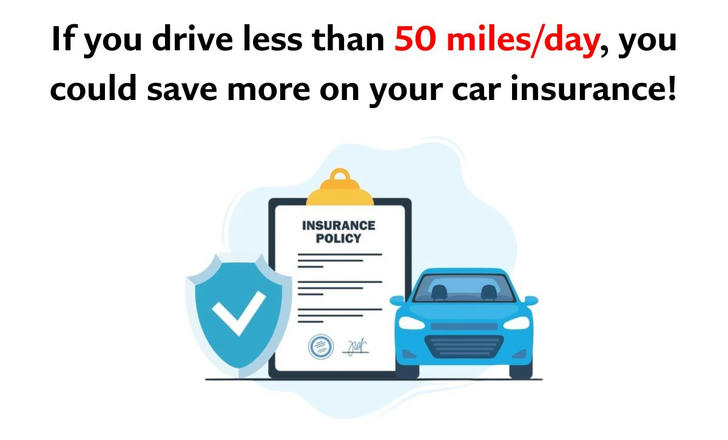🚗 Low-Mileage Car Insurance: Drive Less, Save More
"I can't believe I have been over paying for years. It was so easy to switch and I was able to cut my monthly bill in half." Christine exclaimed
Annual mileage plays a key role in determining car insurance costs. For those who don’t drive frequently, some insurance plans offer mileage-based pricing or specific discounts—helping reduce overall expenses.

✅ What Is Considered Low-Mileage Car Insurance?
Low-mileage car insurance refers to plans designed for vehicles that are driven fewer miles each year. In the U.S., the average driver covers around 13,500 miles annually, which is about 37 miles per day.
Many insurance providers commonly use 50 miles per day (around 18,000 miles per year) as a soft upper limit when describing mileage brackets. Policies may offer more favorable pricing for vehicles staying below that threshold.
Some carriers also offer pay-per-mile options, where monthly premiums are based on actual driving distance—ideal for those who commute infrequently or work remotely.
💰 Is Car Insurance Cheaper if You Drive Less?
In general, lower mileage can mean lower risk. Vehicles on the road less often are less likely to be involved in collisions. That’s why many insurance providers offer mileage-based discounts:
| Annual Mileage | Typical Discount | Approx. Daily Miles |
|---|---|---|
| Under 7,500 miles | Around 10–20% | < 20 miles/day |
| 7,500–10,000 miles | Around 5–10% | 20–27 miles/day |
| 10,000–18,000 miles | Often accepted | Up to 50 miles/day |
| Over 18,000 miles | Standard pricing | — |
Each provider may set different thresholds. Some may ask for maintenance records or install tracking devices to confirm annual mileage.
🏷️ What Are the Best Insurance Options for Low-Mileage Drivers?
1. Pay-Per-Mile Insurance
• Charges a fixed monthly base rate + a per-mile rate
• Designed for cars driven fewer than 8,000 miles/year
• Offered by:
• Metromile
• Mile Auto
• Nationwide SmartMiles
2. Usage-Based Insurance (UBI)
• Tracks driving habits like mileage, acceleration, and braking
• Uses mobile apps or plug-in devices
• Offered by:
• Allstate Drivewise
• Progressive Snapshot
• Liberty Mutual RightTrack
3. Traditional Low-Mileage Discounts
• No tracking required
• Discounts applied based on self-reported mileage
• Suitable for occasional drivers
📊 Low-Mileage Insurance: Company Comparison
The table below outlines common providers offering low-mileage insurance options. Prices are estimates and vary by location, vehicle, and driving history.
| Company | Plan Type | Typical Monthly Cost | Device Required | Notes |
|---|---|---|---|---|
| Metromile | Pay-per-mile | $40–$80 | Yes | Fixed base + mileage-based pricing |
| Nationwide SmartMiles | Pay-per-mile | $50–$90 | Yes | Base fee charged monthly; miles billed later |
| Allstate Drivewise | Usage-based | $60–$110 | Yes | Adjusts based on driving behavior |
| Liberty Mutual RightTrack | Usage-based | $55–$100 | Yes | Intro period determines future discount |
| GEICO | Low-mileage discount | $65–$120 | No | Discounts for reporting low annual mileage |
Note: Rates are estimates only and may vary based on individual quotes.
❓ FAQ: Low-Mileage Car Insurance
Q1: What counts as low mileage?
Most providers consider under 10,000 miles per year to be low. Some offer greater savings below 7,500 miles. The 50 miles/day guideline is often cited as a general reference point.
Q2: What if annual mileage changes?
Some policies allow annual updates. If usage increases or decreases significantly, it’s recommended to notify the insurer for a better match.
Q3: Are tracking devices required?
Pay-per-mile and usage-based plans typically require a device or app. Traditional low-mileage discounts do not, but verification (e.g., service records) may be needed.
Q4: Can short city trips qualify?
Yes. As long as the annual mileage stays within qualifying limits, location or trip type usually doesn’t disqualify a vehicle from potential discounts.
Q5: Can retired or remote workers benefit from low-mileage policies?
Yes—drivers with infrequent commutes or lifestyle-related low usage may often qualify. However, eligibility is based on miles driven, not personal circumstances. Some insurers may offer mileage-related plans regardless of employment or lifestyle.
✍️ Summary
For vehicles driven less than 50 miles a day, there are insurance plans designed to align better with actual use. Whether it’s mileage-based pricing or low-mileage discounts, selecting the right plan can help optimize insurance costs.
Comparing different providers and options can ensure a more accurate and cost-effective fit.
